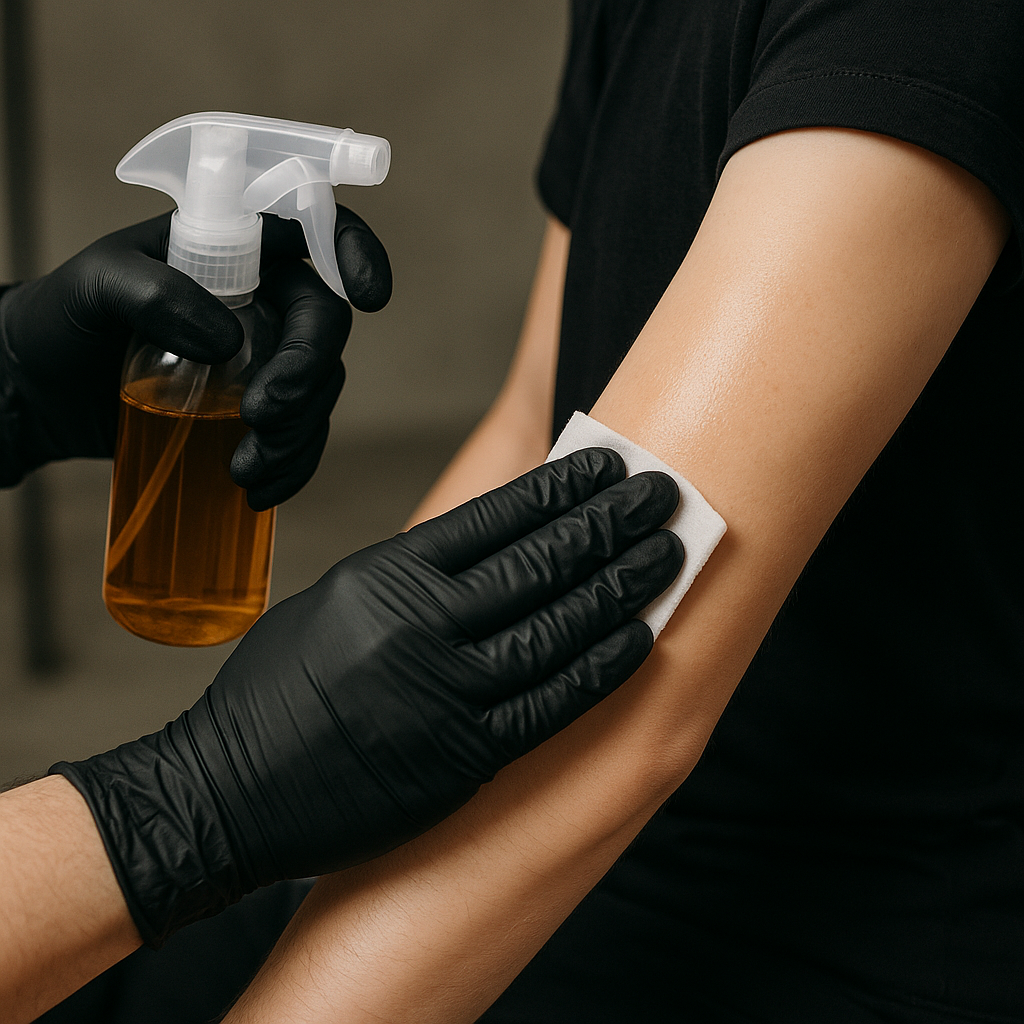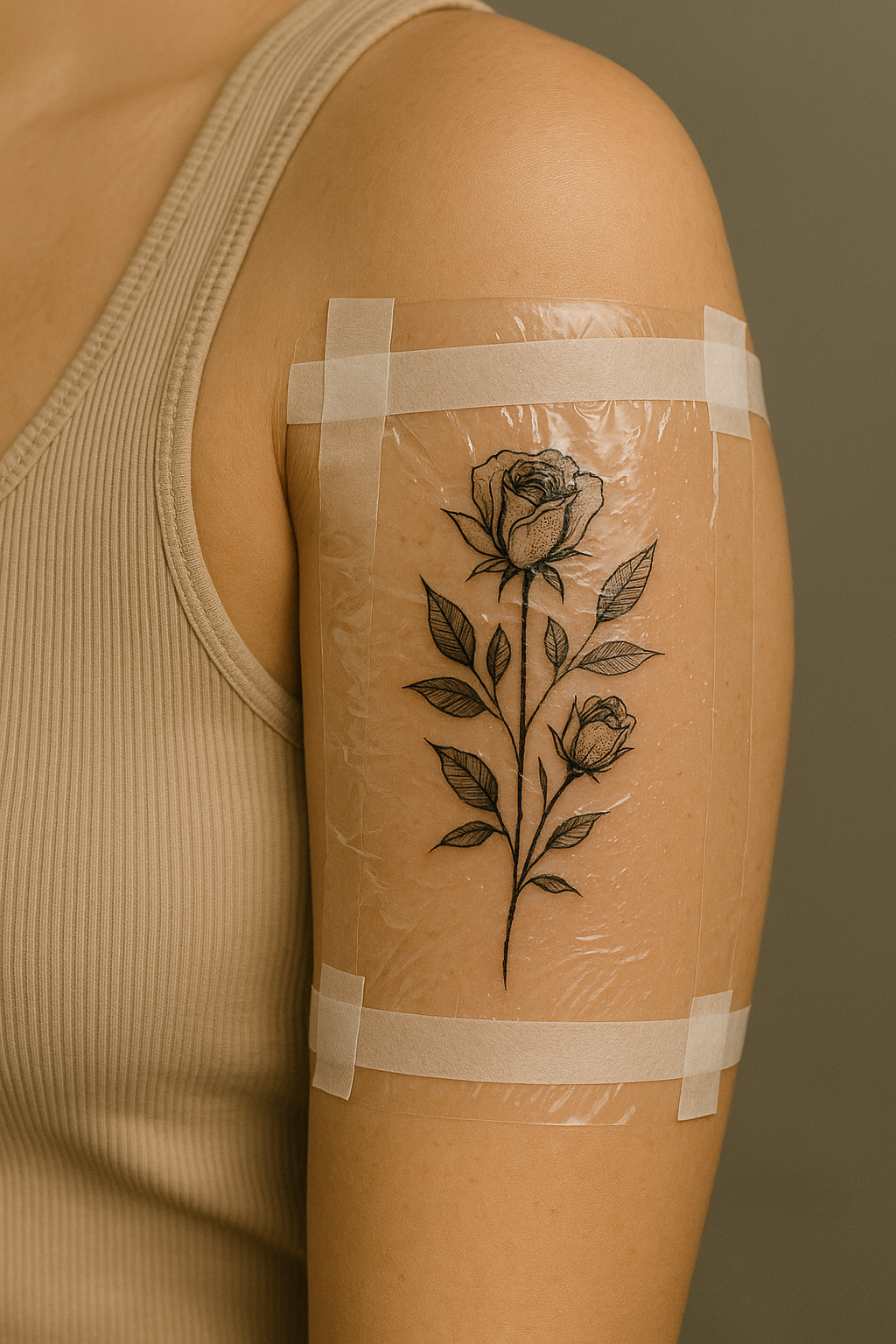
Because great tattoos start with clear expectations.
Preparing your skin properly before getting tattooed is essential for ensuring the best results and promoting smooth healing. Here’s a complete guide:
1. Hydrate and Moisturize Regularly (1–2 Weeks Before)
• Drink water: Keep your body and skin well-hydrated to improve skin elasticity.
• Moisturize daily: Use a gentle, fragrance-free moisturizer on the area to be tattooed. Well-moisturized skin absorbs ink better and heals more easily.
• Avoid moisturizing on the day of: Your artist needs clean, dry skin to work on.
2. Rest Well Before Your Appointment
• Get a full night’s sleep before your session. Being well-rested helps with pain tolerance and keeps your immune system strong.
3. Eat a Good Meal Before Your Appointment
• Eat a nutritious, filling meal 1–2 hours before your tattoo. This stabilizes blood sugar levels, which helps with endurance and reduces the risk of fainting or dizziness.
4. Avoid Alcohol, Caffeine, and Blood Thinners
• 24–48 hours before your appointment:
• No alcohol – it thins the blood and increases bleeding.
• Limit or avoid caffeine – it may increase sensitivity and restlessness.
• Avoid aspirin, ibuprofen, and other blood thinners unless medically necessary.
5. Shave and Clean the Area (if needed)
• If your artist hasn’t asked otherwise, you can gently shave the area the night before with a clean razor.
• Do not shave if you have cuts, irritation, acne, or sunburn.
• Always shower before your appointment and arrive with clean skin – but don’t apply lotion, perfume, or oils.
6. What to Bring to Your Appointment
• Snacks and water: For longer sessions, keeping your energy up is important.
• Comfy clothing: Wear loose-fitting clothes that expose the tattoo area or can be moved easily.
• Entertainment: Bring headphones, books, or a phone charger for distraction during long sessions.
7. Avoid Tanning and Sunburns
• Avoid sun exposure and tanning beds for at least 1–2 weeks prior. Sun-damaged skin is sensitive, prone to damage, and not suitable for tattooing.
8. Let Your Artist Know About Health Conditions
• Disclose any skin conditions, allergies, medications, or illnesses that might affect the process or healing.
• If you’re feeling sick, reschedule. A healthy immune system is crucial for healing.
Tattoo coming up… do I numb or tough it out?
Talk to Your Tattoo Artist First
• ALWAYS check with your artist before using numbing cream.
• Some artists prefer specific brands or do not allow numbing products due to how they affect skin texture, ink saturation, or healing.
• They might even apply it for you in the shop using approved methods.
Understand What Numbing Cream Does
• Numbing creams (topical anesthetics) use ingredients like lidocaine to temporarily dull nerve endings in the skin.
• They reduce pain, but don’t eliminate it completely, especially for deeper needle passes or long sessions.
• Numbing typically lasts 30 minutes to a few hours, depending on the product and how it’s applied.
• Avoid cheap or unregulated brands — some can cause skin reactions or be unsafe in high doses.
Possible Side Effects or Risks
• Redness, itching, or rash from an allergic reaction.
• If over-applied, lidocaine can be toxic, especially if it gets absorbed in large amounts over a large surface area.
• Some creams can cause skin swelling or changes in texture, making tattooing harder.
Numbed areas may feel fine at first, but once the cream wears off, pain can return suddenly. Be prepared for that.
• Follow your artist’s aftercare instructions carefully — some numbing products can slightly delay healing.
Proper Timing & Application
If your artist approves self-application, follow these general steps:
How to Apply Numbing Cream:
1. Clean the area with mild soap and warm water.
2. Pat dry.
3. Apply a thick, even layer of the cream — don’t rub it in completely.
4. Cover with plastic wrap (like Saran Wrap) to trap heat and activate the cream.
5. Leave on for 45–60 minutes.
6. Remove wrap and wipe the cream off completely before your tattoo begins.
Never apply numbing cream too early or leave it on too long — it can irritate the skin or affect results.

Understanding your tattoo artist’s design timing and creative process is one of the most important — yet often overlooked — parts of the tattoo experience. Here’s why it matters, and how respecting that process leads to better art, smoother communication, and a stronger artist-client relationship.
1. Every Artist Works Differently
Tattoo artists are not one-size-fits-all — they each have their own rhythm, approach, and creative flow. For example:
• Some design on the spot after consulting with you, especially for freehand or illustrative work.
• Others need several days (or weeks) to sketch, revise, and fine-tune details.
• Some require precise references while others work best with creative freedom.
• Some artists prefer to show the design only on the day of the appointment to keep the flow fresh and avoid over-editing.
Respecting this is crucial. A rushed design or constant changes can compromise both quality and vision.
2. Design Time Is Part of the Tattoo Process
Tattooing isn’t just about the needle — design prep takes time, thought, and emotional investment.
• Artists may need several hours or more behind the scenes to create a design that fits your body, your concept, and their style.
• Time spent drawing = time not tattooing or resting, especially in busy studios.
• Asking for daily updates or expecting the design far in advance can pressure the artist unnecessarily.
Being patient shows trust — and trust allows your artist to create their best work.
3. Open Communication Builds Mutual Respect
Clear, respectful communication early on helps everyone:
• Be upfront about your ideas, must-haves, and boundaries during booking or the consult.
• Ask how your artist prefers to work:
• “Do you usually send sketches before the appointment?”
• “What’s your ideal timeline for design reviews?”
• Understand that last-minute changes can affect the entire tattoo flow and may require rescheduling or additional fees.
Instead of micromanaging, ask how to best support their process.
4. Collaborative Energy = Better Tattoos
Tattoos are a collaboration — your story and vision, paired with the artist’s interpretation and technical skill.
• Giving space for the artist to make decisions about placement, flow, size, and linework often results in tattoos that fit and heal better.
• Trust doesn’t mean silence — it means participating with flexibility and openness.
Artists are professionals who want you to love your piece. Let them guide you with confidence.
5. What to Avoid
• Rushing the artist with repeated DMs or urgent requests.
• Expecting free redraws or design previews without understanding studio policy.
• Assuming every artist will work like the last one you had — even within the same shop, everyone’s process is unique.
Tattoo Aftercare: What to Do and What to Avoid
1. Leave the Bandage On
Keep the bandage on for at least 2 hours after your session.
When removing, wash your hands thoroughly, then carefully peel away the bandage under warm running water.
Do not rip it off dry—this helps prevent skin damage.
2. Wash the Tattoo
Use warm water and an unscented antibacterial soap (like Dial or Dr. Bronner’s).
Gently wash the area with your hand only—no washcloths or sponges.
Pat dry with a clean paper towel or allow it to air dry.
Avoid using a regular towel to prevent bacteria or lint buildup.
3. Apply Ointment
Apply a thin layer of an antibiotic ointment like Aquaphor, Bacitracin, or Neomycin-Polymyxin.
Do not glob it on—your skin needs to breathe.
4. Repeat for 3 Days
Repeat the wash → dry → ointment process 2–4 times daily for the first 3 days.
5. General Healing Guidelines
Do NOT rebandage once the initial bandage is off.
Expect peeling like sunburn after a few days—this is normal.
Healing takes about 7 to 10 days, depending on tattoo size and location.
Avoid These During Healing
No direct sunlight on the tattoo for 2–3 weeks.
Do not pick or scratch as it peels.
No soaking—no swimming, baths, hot tubs, or saunas for 2 weeks.
No shaving or waxing the area until it’s fully healed.
Avoid alcohol, Vaseline, petroleum jelly, and sunblock on fresh tattoos.
When in Doubt, Contact Us
Don’t rely on friends or internet tips—if you have questions, reach out to your artist.
Seek Medical Attention If You Notice:
Unexpected redness, swelling, or tenderness
A rash at or near the tattoo site
Unusual drainage from the tattoo
Fever within 24 hours of getting tattooed
Call your artist, then contact your doctor. Better safe than sorry.


